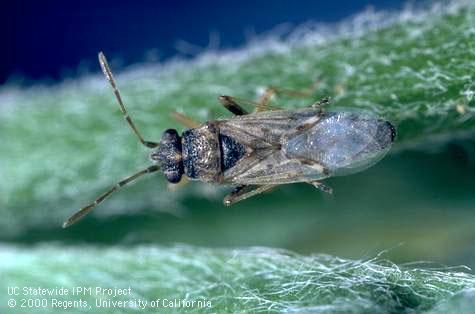False Chinch Bug
April 2005
David Haviland, Walt Bentley, Ed Weber
False chinch bug, Nysius raphanus Howard (Hemiptera: Lygaeidae), is an occasional pest that may breed in countless numbers in weeds within and adjacent to vineyards in early spring. When weed hosts dry, migration to green plants occurs. A vineyard situated in their path may suffer serious injury, usually in the prebloom period. When forced to leave drying hosts, the wingless immature stage predominates. Consequently, migrating insects do not fly, but walk. Winged adults may also be present, but instead of flying they march along with the wingless immatures. False chinch bugs are rarely a problem during the summer, but can occur in the fall. Migrations generally occur in the late evening or early morning. During the heat of the day, they may be found under plant debris and soil clods.Description
Adults are about 3 mm (1/8 inch) long and are light or dark gray. Be careful not to confuse them with small lygus bugs or big-eyed bugs; the latter of which have wider and flatter heads. The nymphs are gray with reddish brown abdomens. They have piercing-sucking mouthparts.
Injury
When mass migrations of false chinch bugs invade a vineyard, they swarm up trunks of vines to leaves where they immediately begin to suck juices. Within a few hours, leaves on a healthy, vigorous vine may wilt and eventually turn brown as though burned. Heavy infestations of nymphs and adults can completely kill back new growth on established vines. Heavy feeding on young vines, especially those still being trained, can result in complete vine death. Some scientists hypothesize that a toxin is involved due to how quickly the leaves collapse and dry. Under most circumstances, heavy damage is usually isolated to vines near field edges, especially those on the edge from which the migration is originating.
Seasonal Development
Eggs are laid at random on rubble in the soil or in cracks in the ground. All stages may hibernate, but most pass the winter as immatures. There are about six generations each year. Population pressure, which exhausts their food supply in the fall, may produce fall migrations.
Overwintering false chinch bug adults are strongly attracted to London rocket as well as other plants in the mustard family such as shepherd's purse, mustard, wild radish and pepperweed. They gather in large numbers on stands of these weeds in late February and early March. There, they produce nymphal populations that will attack grapevines when the weeds dry up or are turned under after the vines leaf out. The most serious and destructive migrations occur in May and June, but there are occasional migrations in September and October.
Natural Control
Little, if any, information is available on the natural control of false chinch bug.
Monitoring Guidelines
During the spring, monitor for false chinch bugs on weed hosts such as London rocket, wild mustard, wild radish, and shepherd's purse. This can be done visually with or without a sweep net on larger weeds, or by uprooting plants to expose bugs hiding near the soil surface.
Monitor both within and outside the vineyard. In-field monitoring is important to determine resident populations of this pest, whereas monitoring weedy ditchbanks and pastures near the vineyard can give an indication of the potential for mass false chinch bug migrations.
If large numbers of false chinch bug are found on weed hosts (especially if those weed hosts are drying down), inspect vines for damage. Look for false chinch bugs on the vines and a wilted, scorched appearance to the leaves. On young vines, look inside the cartons used to protect the trunks; false chinch bugs will often hide inside these cartons and feed on the vine. Do this in the evening when the insects are more active.
Management Guidelines
Control is best achieved by disking up the weeds in and near the vineyards to prevent buildup of bugs. If false chinch bugs have been a problem in past years, stands of London rocket and other host weeds should be disked under or otherwise reduced about 3 weeks before grapevines leaf out. If disking has not been achieved by this time, and large populations are found on the weeds, apply insecticides. Disking without first applying insecticides after the vines have leafed out will likely result in the movement of this pest off of the weeds and onto the vines.
If an insecticide is used, apply it in the early morning or late evening when the majority of the population is exposed and moving. If nymphs are found moving onto vines, apply an insecticide at once to both vines and weed sources. If the vineyard is young and still has cartons over the trunks, consider killing the bugs before they start moving to the vines; the efficacy of insecticides on bugs once they are hidden in the cartons is greatly reduced.
Since false cinch bugs migrate mainly in one direction, wilted vines along one edge of the vineyard can clearly indicate from which direction they are entering. In many cases, treatments to border rows on the one side of the field are sufficient to protect the entire vineyard. Alternatively, a water barrier may prevent movement to the crop.

